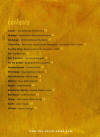|
|
the-south-asian.com August 2007 |
|
|||
|
Famous
Bazaars
Business Ratan Tata
Remaining articles
|
|
||||
|
Page 2 of 2
The challenge of poppy eradication The best strategy to fight narcotics in Afghanistan or anywhere is to prevent its cultivation. Once it is cultivated it is already too late and the society pays a high social and economic price. The real fight against narcotics is to provide alternative development. “If you give the choice of life and death to anyone – they choose life even if it is illegal. If you give them a choice between dignified and undignified life no human being anywhere in the world will opt to be a criminal if they have another option to live.” Building roads, providing access to markets is very important. To convince a farmer to grow grapes or pomegranates or other things, he has to be assured that once he has cultivated grapes there is a market for him to sell, a road for him to take the grapes. Fighting narcotics is a long-term ‘improving the life of people’ project. Alternative crops have been experimented in Afghanistan eg. saffron – they have their implications, and serious limitations because one needs to provide the infrastructure for these products to get to the market. Some of the provinces are already poppy-free. There is a direct connection between insecurity and narcotics. Some of the areas where the heaviest fighting is taking place eg. Sangin is the biggest mall for narcotics. There is a lot of money there. It is a small village in the district of Helmand but the car dealers there are fancier than in Tysons Corner in Virginia, USA. Regional challenges Afghanistan is situated in a difficult neighbourhood. It has very good relations with its neighbours in the north, with Pakistan, Tajikistan but there is a lot more potential to do a lot more with them economically. China has been very helpful in the reconstruction process in Afghanistan. India is playing an important role. Commenting on relations with Pakistan, the Ambassador quoted Mark Twain, who was once asked to comment on the music of Wagner. “Mark Twain said that ‘It’s better than it sounds’. Our relation with Pakistan is better than it sounds despite the complications that we have.” There is a strong dialogue between the two Presidents – there is a positive trend of things improving further. The best course of action is to eliminate institutional support for extremism and build capacity for a civil society and emphasize trade. During the time of Taliban the trade Afghanistan conducted in Pakistan was $60 million. Today it is $1.4 billion – a lot of that is input from Pakistan. Afghanistan still does not produce enough to export. There is a lot more potential. Afghanistan would like Iran to play a constructive role in Afghanistan – it will benefit both countries in the region.
Reconstruction assistance to Afghanistan Reconstruction aid to Afghanistan in 2006 amounted to about $7 billion of which $1 billion was delivered to the Afghan government or to the Budget of the Afghan government. “We are already paying the price of doing too little in Afghanistan.” It is true that spending 1 or 2 billion dollars to build the capacity of the Afghan National Army is a lot of money. The Afghan people are willing and ready to defend their country. “There is no word for us Afghans to show our gratitude not only for financial assistance but equally in terms of military sacrifices. When President Karzai was here I took him to Walter Reed Hospital to pay our gratitude to those who have been fighting in Afghanistan. Some of you might disagree with the mission of being in Afghanistan but when you look at these individual soldiers who are fighting there - they are the true heroes. Some of them have hardly been out of their own state – and suddenly they are deployed to Afghanistan. They come there and they still retain their good spirits. While at the hospital we met a lady from New Jersey in her mid-fifties. She is the mother of five sons - ages 6 to 25. She was injured in Afghanistan while building roads - how worthy is this of her life? We would rather have her back in New Jersey with her family and do the reconstruction of our country and the defence of our country ourselves – if we are provided with the resources and the capabilities.” “Fortunately, there is an understanding on the need to do more in Afghanistan – and we appreciate it – particularly the leadership of the New Congress and the administration to work together to make sure that Afghanistan receives additional resources.” Of the $11.8 billion that will be allocated to Afghanistan, about 8 billion will be spent on training the police and the National Army of Afghanistan. About 1 billion will be used for capacity building and to strengthen good governance and national institutions in Afghanistan and 1 billion each on reconstruction and alternative livelihood.
Roads are a big priority for the Afghan government. The construction of the Ring Road has been completed. This will connect Afghanistan to the Indian subcontinent, Central Asia and the Middle East. While some progress has been made in construction of roads, there remains a serious challenge of providing energy in Afghanistan. Only 9% of Afghans have access to electricity. The government is working on building a national grid right now. A number of power plants are temporary measures, which are not sustainable and an expensive way of providing electricity. The Kajaki dam built by the U.S. in Helmand valley in the 60s is undergoing reconstruction. This is an area where there are a lot of security challenges. The other option is to import electricity from Tajikistan, Uzbekistan, and also oil from Turkmenistan to provide energy.
Progress during the last five years Despite all these challenges a lot of progress has been made in Afghanistan. The average growth in the past 5 years has been 16.5%. About 4.5 million refugees have returned to Afghanistan, which shows their confidence in the political process. More than 6.5 million children are back in school compared to less than a million during the Taliban. The government’s aim is to make the private sector the real engine for the growth, provided investment is made in the infrastructure and an enabling environment provided for the private sector. Almost the entire country is connected through a new system of telecommunications, mostly done by the private sector. The Afghan government is looking for serious investment in oil and natural gas as well as minerals, particularly copper. Afghanistan has the second largest copper mine in the world. Right now the Afghan government is collecting bids – it is going to be a major investment in Afghanistan. Other projects of interest are agri-business and food processing. This is briefly the picture today. Afghanistan has an elected president, an elected parliament, and one of the most enlightened constitutions in that part of the world. Women were completely absent from the public life during the rule of Taliban. Today there are more than 74 women elected in the parliament. Twelve percent of the state employees are women and close to 30% of the teachers are women compared to only 1.45% women teachers before the War on Terror and Violence. The GDP growth of $8.8 billion has been very impressive. Some of the sectors that have done very well are service industry and banking. Over 30 banks opened their branches in Afghanistan as soon as the new law was adopted. Media and TV are other prime examples. There are close to 250-260 publications and newspapers, and 17 privately owned TV stations. Some TV stations are owned by women and are broadcasting only for women. The most important asset for the Afghan people is the way they perceive their engagement with the international community. Majority of Afghans are seeking international partnership and support. The feelings of Afghans towards the international community are still positive despite the frustration that they haven’t seen much improvement in their daily lives. *****
|
|||||
|
Copyright © 2000 - 2007 [the-south-asian.com]. Intellectual Property. All rights reserved. |
|||||

